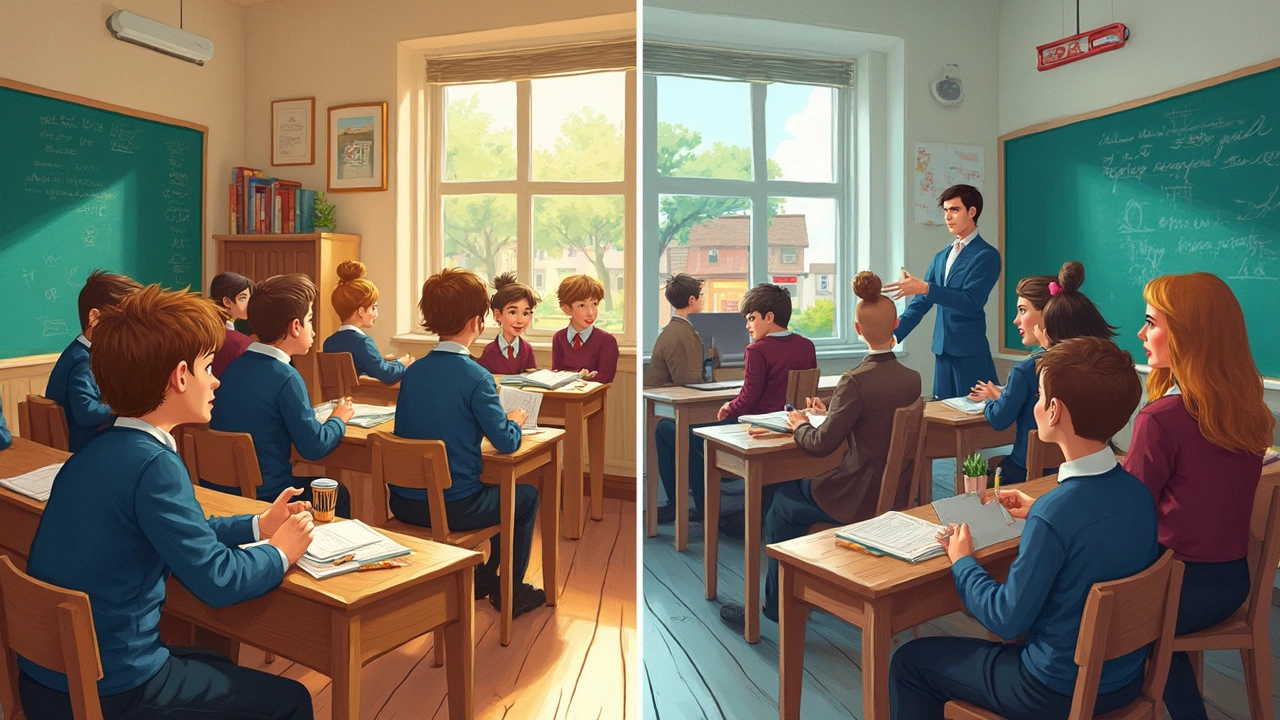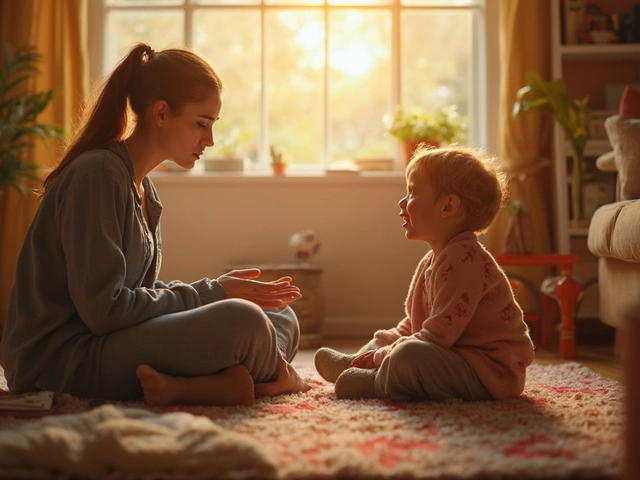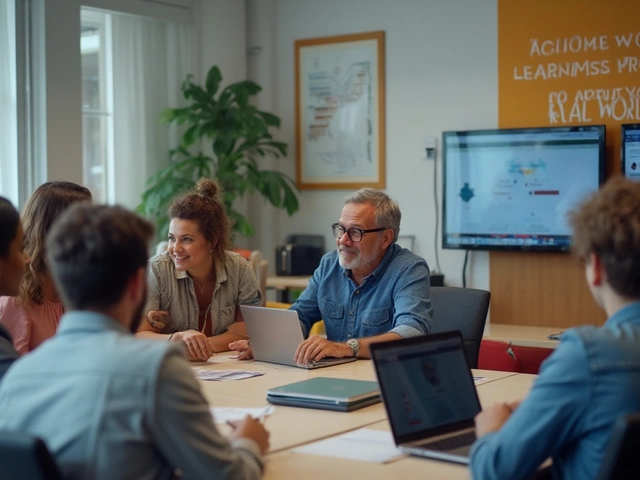So, you're wondering if online school measures up to the in-person experience you might remember. The rise of virtual classrooms has sparked a massive shift in how we think about education. It used to be all about rushing to class in the morning, right? Now, you can do it all from home—pajamas and all!
Online education offers some incredible perks, like flexibility and comfort, but that's not the whole story. What's happening to the good old social interactions? And how effective is this new method in keeping us engaged and actually learning something? Not all subjects feel the same when tackled through a screen. Imagine trying to do gym class online!
Let's dig deeper into what online schooling really means. From understanding its core structure and how it compares to regular schools, to dealing with its unique set of challenges—there's a lot to unpack. If you're looking to get the most out of your online learning experience, we're going to cover some must-know tips and tricks to help you thrive in this digital academic world. Are you ready to dive in?
- Understanding Online Schooling
- Differences Between Online and Regular Schools
- The Social Aspect of Online Learning
- Effectiveness: Learning Outcomes Compared
- Challenges and Solutions in Online Education
- Tips for Thriving in an Online School Environment
Understanding Online Schooling
Online schooling has become a big thing, but what exactly is it all about? Think of it as attending classes but through your computer. In a distance learning setup, you join virtual classrooms where everything happens over the internet. No physical school building required!
Most online schools use platforms like Zoom or Google Classroom to manage lessons. Students can listen to teachers, ask questions, and even join discussions just like they would in a real classroom—but all from their own homes.
A neat feature of online schooling is flexibility. Imagine schooling that lets you adjust according to your daily life. Some programs offer pre-recorded lectures, letting you watch whenever you want. This means if you're someone who thinks better at night, you can study then, unlike regular schools with fixed timings.
Online education also brings a world of resources. Digital tools like e-books, video tutorials, and quizzes are right at your fingertips. Many schools provide access to a massive library of online materials. If textbooks were your only go-to in regular schools, think of this as an all-you-can-eat buffet for your mind.
On the technology side, having a decent internet connection and a computer are must-haves. Schools typically guide you on what software you'll need. With proper setups, learning can actually feel pretty seamless, though it's wise to keep a backup plan (like hotspot access) for those annoying tech glitches.
For those skeptical about its efficacy, there are statistics to lean on. Studies have shown that students in online learning boasted slightly better performance due to self-pacing. A
| Study Type | Improvement |
|---|---|
| Self-paced Learning | 15% better results |
| Instructor-led Learning | 8% better results |
In summary, while virtual classrooms might sound vastly different, the core aim remains the same: learning and growing. It's just a new-age way of doing what schools have been doing forever, just with a digital twist!
Differences Between Online and Regular Schools
Alright, so let’s talk about how online schools stack up against regular brick-and-mortar settings. Right off the bat, the most obvious difference is location. With online schooling, your 'classroom' can be anywhere you have internet—your bedroom, a café, or even a beach (assuming the Wi-Fi works there).
The learning schedule is another biggie. Unlike traditional schools with set hours, online education often lets you choose when to tackle your studies. This flexibility can be awesome if you have other commitments, but it requires some serious self-discipline. No one is looking over your shoulder to make sure you're doing your assignments.
Next up is interaction. In regular schools, you have face-to-face discussions and group activities (and maybe the occasional hallway chat). Online classes, however, rely on digital interaction—think forums, video calls, and chatrooms. It's different, no doubt, and it can sometimes feel less personal. But on the flip side, you might find it easier to speak up when you can type out your thoughts.
How about teaching styles? Traditional schools typically feature direct, in-person teacher guidance. Online education, by contrast, often leans more on independent learning with occasional live or recorded lectures. Resources like virtual simulations or interactive modules can be part of your digital toolkit.
Tech also takes center stage online. You need reliable gadgets—a working computer and decent internet connection are essential. Meanwhile, regular schools might require fewer tech skills, but they don't eliminate them entirely with more schools incorporating tech into their classrooms.
| Aspect | Online Schools | Regular Schools |
|---|---|---|
| Location | Anywhere with internet | Campus/Classroom |
| Schedule | Flexible | Fixed |
| Interaction | Digital | Face-to-face |
| Teaching Style | Independent, Tech-reliant | Direct, In-person |
| Technology | Essential for classes | Supportive, not crucial |
While the core goal remains the same in both setups—helping you learn and grow—the ways they reach this goal are uniquely distinct. And that can really shape your experience.
The Social Aspect of Online Learning
One big question folks often ask about online school is: what about socializing? It's no secret that regular school offers non-stop chances to make friends. You've got lunchtime hangouts, team sports, and group projects. But how does this work in the online school environment? Surprisingly, there are some pretty neat solutions.
Virtual classrooms try to mimic face-to-face interactions. Many schools use video calls and chat rooms to keep students connected. On platforms like Zoom or Microsoft Teams, there are breakout rooms where students can work together. It's not the same as in-person, but it helps bridge the gap a bit.
Of course, it's not all rainbows. Some students find it tough to form connections without daily face-to-face interactions. A study from the National Education Institute in 2023 found that about 60% of online students missed the casual chats they used to have in hallways. This makes some kids feel isolated and left out.
But not all is lost! Here are a few ways online schooling is getting creative with social interactions:
- Online Clubs: Schools are setting up virtual clubs for everything from art to coding. It's a chance to meet other students with similar interests.
- Social Media: Many distance learning schools have online communities on social media platforms. These private groups can be a fun and safe way for students to interact.
- Collaborative Projects: Teachers are using tech to encourage teamwork on projects, helping students bond over shared goals.
But hey, it's still okay to miss the old ways—sports teams, field trips, or just sitting together at lunch. Online schooling asks for a new kind of effort to keep those social ties strong. It might take a bit of adjusting and a dash of creativity, but making friends and feeling a part of a community is totally doable, even in a virtual space.

Effectiveness: Learning Outcomes Compared
When it comes to education, everyone wants to know if they're getting their money's worth, right? With online school growing like crazy, it's natural to wonder how the learning outcomes compare to traditional settings. Are we still absorbing the same amount of knowledge, or are things slipping through the digital cracks?
Studies have shown that the effectiveness of online education often depends on the subject and the level of support provided. For instance, humanities subjects, which require a lot of reading and essays, do pretty well in a virtual environment. The real hiccup comes with subjects that need hands-on practice, like lab science or technical courses. Those tend to pose more challenges online.
One interesting pattern is how learning outcomes can differ based on self-motivation. Students who are self-driven often excel in distance learning settings. Since you're in charge of managing your time, it's a make-or-break factor. But hey, if you're someone who procrastinates until the last minute, the freedom might end up being a curse rather than a blessing.
| Indicator | Online School | Traditional School |
|---|---|---|
| Student Interaction | Low to Moderate | High |
| Flexibility | High | Low |
| Teacher Feedback | Varies | Consistent |
Want a tip for success? Make use of those online forums and discussion boards! They're goldmines for interaction and support. Plus, you'll be surprised at how searchable and accessible your materials are online—wave goodbye to misplaced notes forever.
So, is virtual learning as effective as hitting the books in a classroom? In many ways, yes. But it calls for a different kind of discipline and adaptability. Stay organized, keep in touch with your teachers, and use tech to your advantage. You've got all the tools you need right at your fingertips!
Challenges and Solutions in Online Education
Switching to online school is a bit like moving to a new country. Suddenly, everything's different, and not always in ways you expect. While it’s exciting, it comes with its own set of challenges.
The first big hurdle? Isolation. When you’re not physically with your classmates, it can feel like you’re missing out on social interactions, group study sessions, and basically, all the fun stuff that happens in a regular school. Loneliness in the virtual classroom is real.
But this isn’t a dead-end. A quick fix is setting up regular video calls with classmates for group projects or even casual chats. Join online study groups or forums related to your course. Learning can be collaborative if you make it happen!
“While online education is practical, students need to be proactive in ensuring they stay connected and supported,” says Dr. Ashley Woods, an education expert from Stanford.
Another issue is staying motivated. When your bed is two steps away, the couch five, how do you focus? Try setting up a designated study space that’s away from distractions. Use planners or digital tools to keep track of your assignments. Stick to a routine, however flexible it might be.
And let's not forget about tech issues. A slow internet connection today could mean missing out on a crucial class discussion. Always have a backup plan, like recorded lectures or accessible online resources.
Distance learning presents its unique challenges, but with a bit of effort and the right tools, these hurdles can actually sharpen our problem-solving skills and adaptability. Want to succeed? Embrace the change and tackle each issue head-on!
Tips for Thriving in an Online School Environment
Learning online might seem like a breeze at first—no crowded buses, no long commutes. But it comes with its own set of challenges. So how can you make the most of your online school experience? Let's break it down!
First off, setting up a dedicated study space is crucial. You want somewhere you can focus, free from distractions. Whether it's a corner of your bedroom or a spot in the living room, make sure it's well-organized and comfortable.
Next, schedule your day like you would in a regular school. Block out time for classes, but also for breaks. The Pomodoro Technique is great for this – study for 25 minutes, then take a 5-minute break. Rinse and repeat!
- Stay organized: Use planners or digital tools like Google Calendar to keep track of assignments and deadlines.
- Engage with your classmates: Participating in online forums or study groups can make a big difference. You might feel like you’re going solo, but don't forget your peers are just a click away.
- Reach out to teachers: Don’t hesitate to ask questions or request help during live sessions or via email. Remember, your instructors want you to succeed.
- Keep distractions at bay: It's easy to get off track with social media just a tab away. Consider apps like Freedom or Focus@Will to block distracting sites and create a productive atmosphere.
- Stay healthy: Remember to include some physical activity in your daily routine. It's amazing how a short walk or some stretches can clear your mind.
Now, while online classes are flexible, this format requires a good amount of self-discipline. According to a recent survey, students who set goals and monitor their progress tend to perform better. Look at your schooling as a personal project: set goals, track achievements, and reward yourself for milestones.
Staying motivated might be your toughest nut to crack. Try setting small, achievable goals for each class or subject. It could be as simple as mastering a new concept or completing an assignment a day early. Small wins lead to big successes!
If you stick with these tips, you'll not only survive but thrive in the distance learning environment. It's all about finding what works best for you and rolling with it. Here's to rocking your virtual classrooms!






